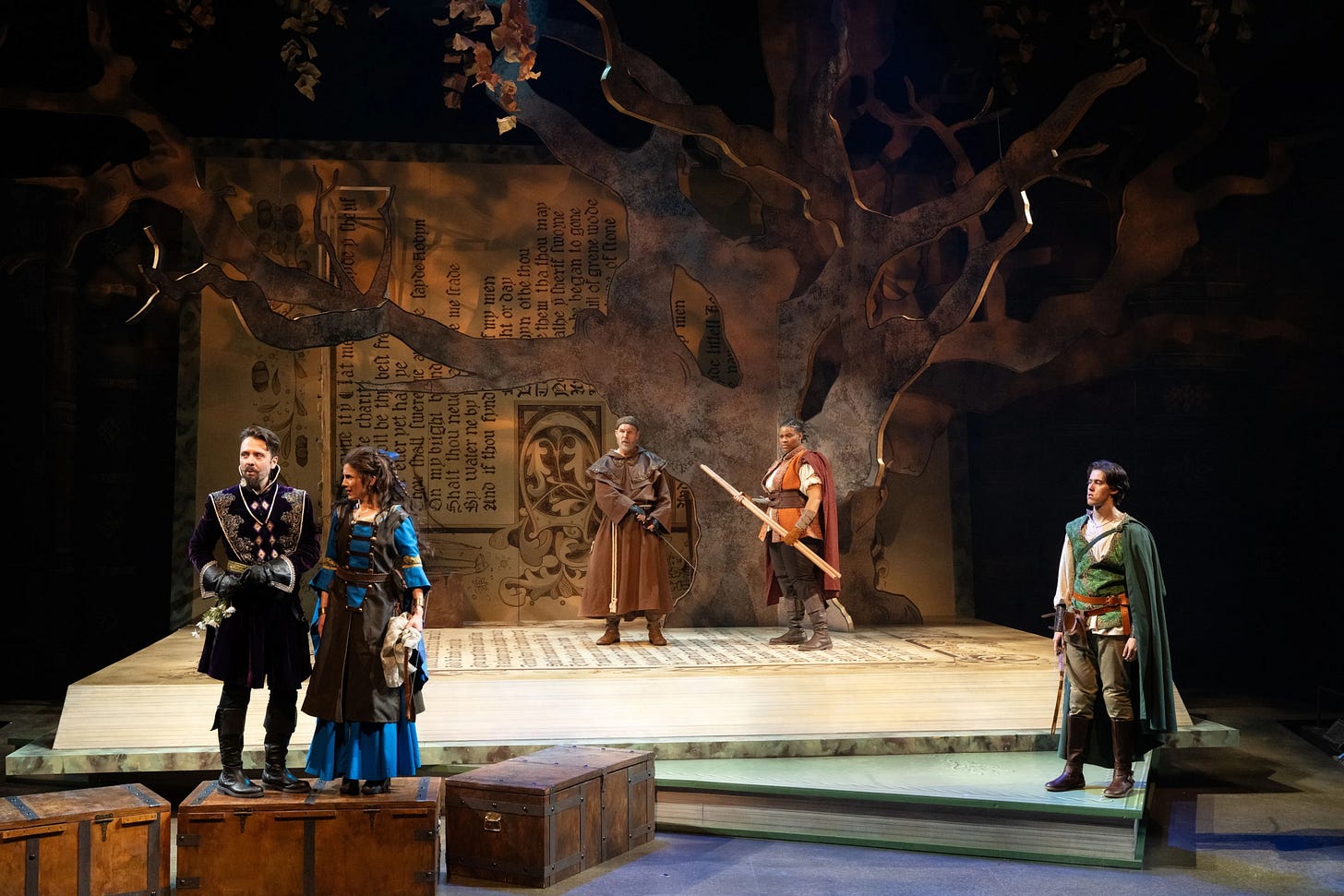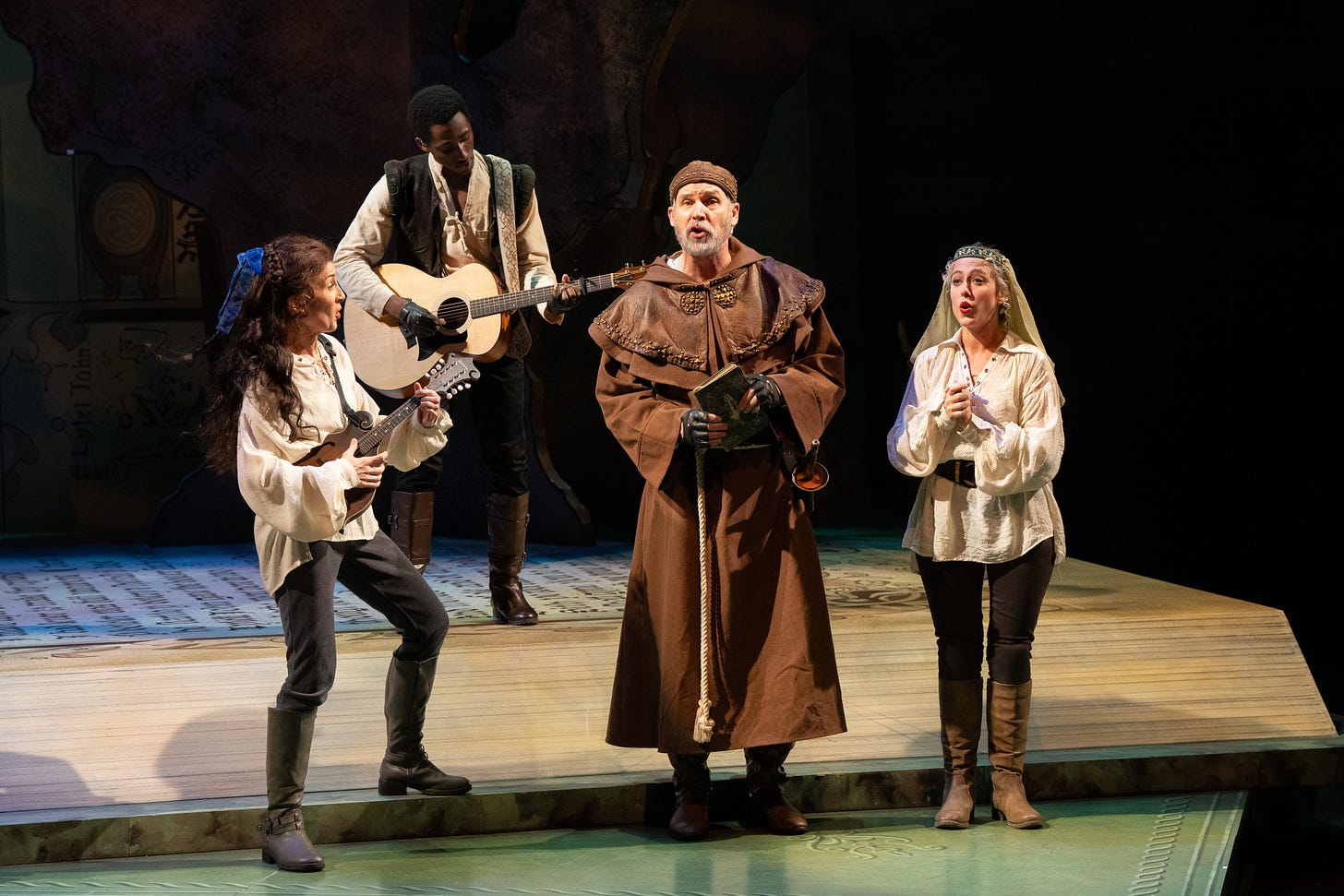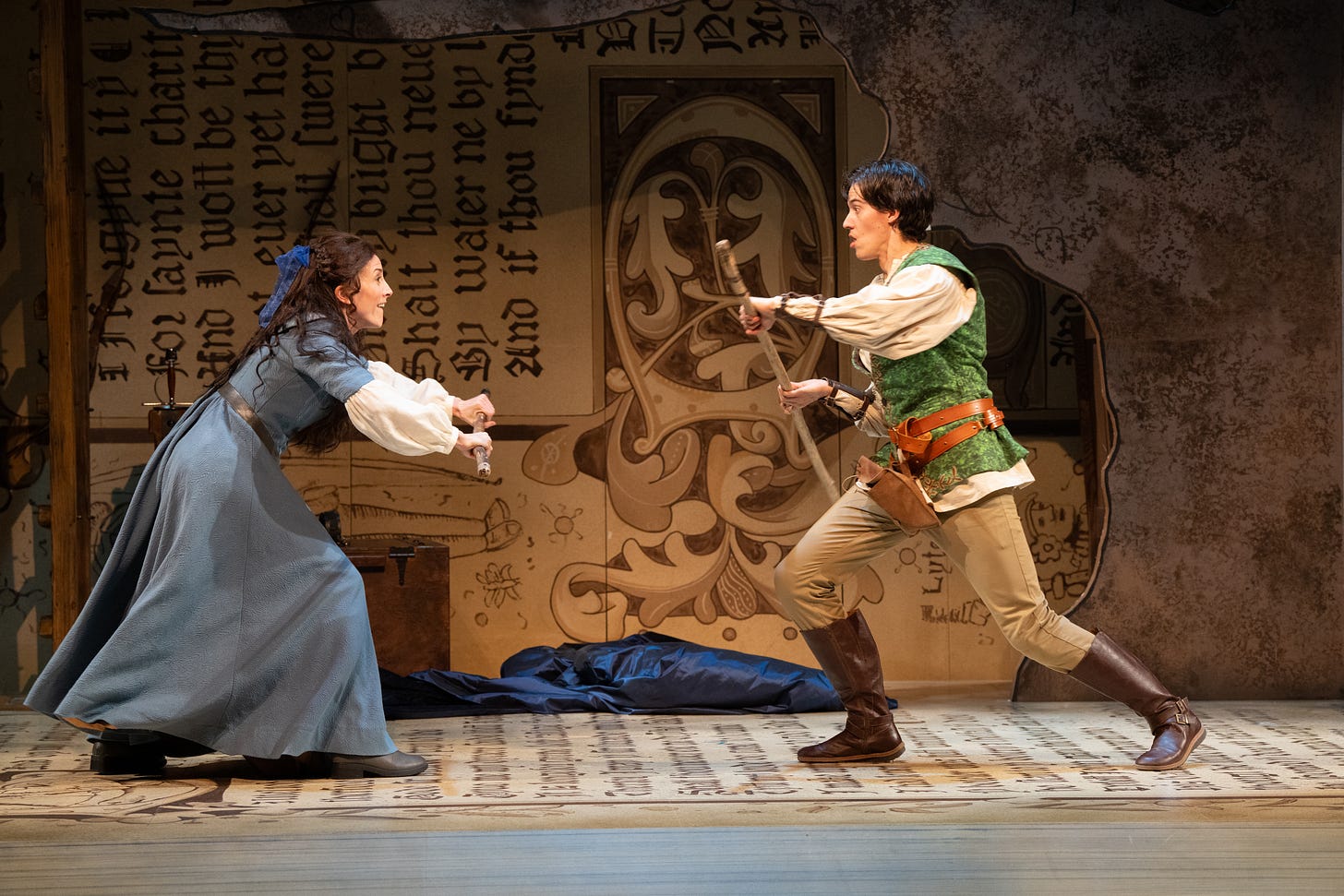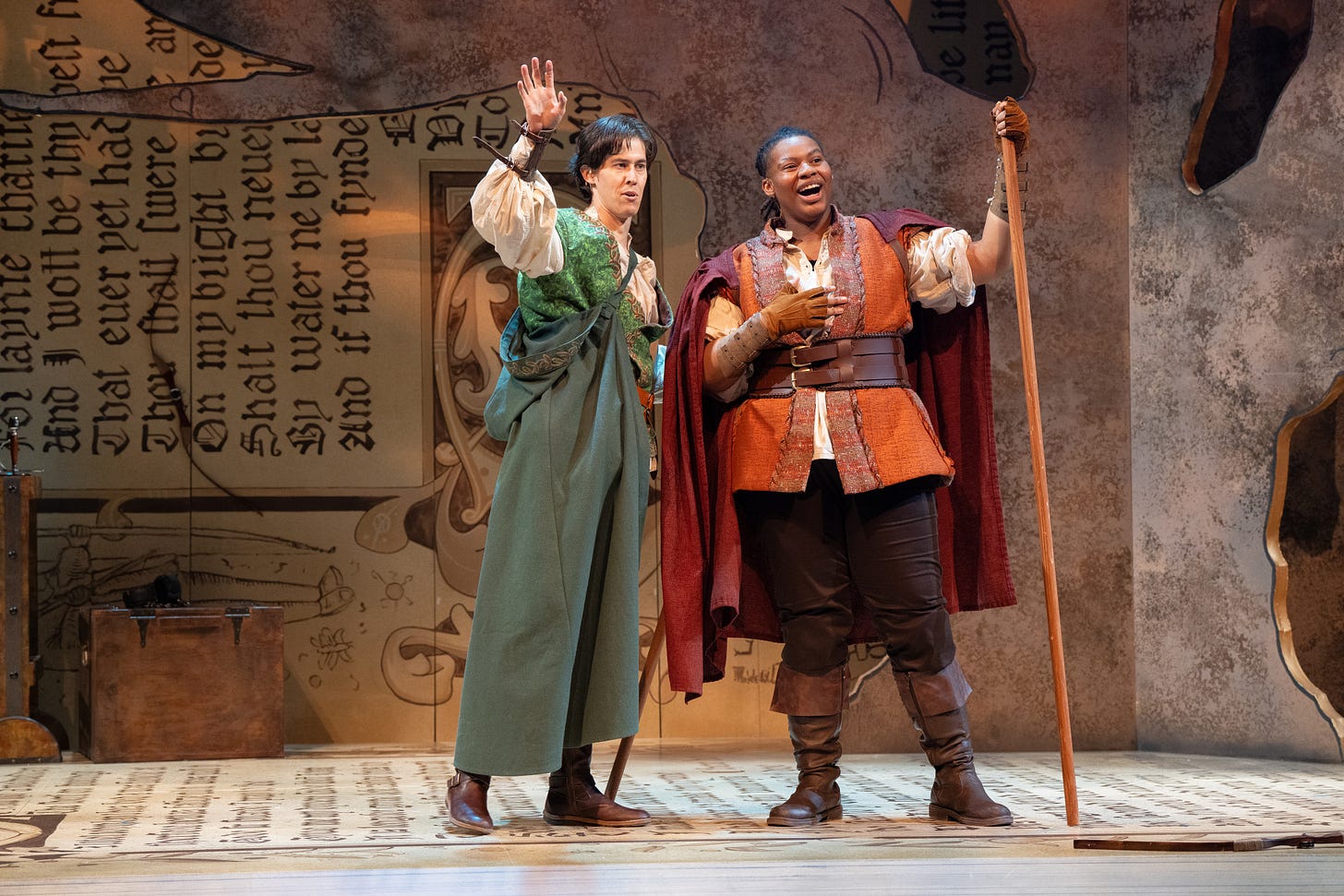Through April 13: The Rep’s Aim Is True With “Sherwood: The Adventures of Robin Hood”
This light romp offers a captivating blend of humor, action and engaging performances
In my STL Stage Snaps short video review, I said that The Repertory Theatre of St. Louis’ current production of Ken Ludwig’s “Sherwood: The Adventures of Robin Hood” was the sort of play that practically recommends itself. What I should have said was that it is a play and production that recommends itself because it offers a decent story, strong, recognizable characters and engaging visual and technical elements (including a storybook set and flying arrows), as well as strong direction and rousing performances by the actors.
One of the superpowers of live theater is the way some elements can coalesce, overcome and compensate for shortcomings in other elements. It’s said that great writers are experts at “writing around” their weaknesses so well that you don’t notice them. By way of analogy, director Kate Bergstrom uses her magician’s touch to deflect attention from Ludwig’s generally shallow “Sherwood” by skillfully interpreting the script, guiding actors to authentic performances and seamlessly integrating visual and technical elements to create a cohesive and engaging production.
Her vision and leadership are the foundation of this satisfying theatrical experience – as long as you don’t look too deep. The success in “Sherwood” isn’t in the material – it’s in the execution. The vibe is energetic; the experience is a fun romp.
It's easy to understand why Bergstrom chose “Sherwood.” Not every play needs to be Strindberg. It’s family friendly, filled with well-aimed fun and is the work of a popular playwright. Ludwig is a celebrated American playwright, author, screenwriter and director whose works have been performed in more than 30 countries and translated into more than 20 languages. He has had six productions on Broadway and eight in London's West End, including his adaptation of Agatha Christie's “Murder on the Orient Express” and his musical “Crazy for You.” His “Sherwood” fits seamlessly into his oeuvre, reflecting his penchant for blending humor, adventure and romance.
If there were a review aggregator like Rotten Tomatoes for plays (didtheylikeit.com and Show-score.com don’t count), the group consensus would probably be that “Sherwood” isn’t Ludwigs best play – but it’s certainly not a stinker, either. This play reimagines the classic tale of Robin Hood with a lighthearted and comedic spin, while also addressing themes of social justice and personal responsibility. Like many of Ludwig's works, “Sherwood” combines historical and literary elements with contemporary relevance.
To borrow an archery analogy, the play’s quiver is filled with the slings and arrows of Robin Hood and his Merry Them (rather than Men) – a pleasing pastiche of affection-grabbing, familiar characters (the royalty are fops, the Merry Band are lovable scalawags), sight gags and not-so-hidden Shakespearean and Monty Python Easter eggs (as well as classic English ballads from the 14th and 15th centuries) – all wrapped up with predictable rom-commie love stories.
Bergstrom and her creative team employ high jinxs, shenanigans and a staccato-paced action to create a satisfying, laughter-laced theatrical experience. With nary a weak cast member, the audience is continuously engaged in the action and plot developments with no time to ponder anything deeper. One of the stand-out aspects of this production is the chance to sit with an audience and share laughs. Another is the way characters shoot arrows at targets both animate and inanimate. It’s not clear how the visual magic tricks are accomplished, but they never get tiresome to behold.
One of the smartest things Ludwig did in this reinterpretation of the OG men in tights (circa Common Era 1194) is to transform Maid Marian from a damsel in need of rescue into a bold warrior in need of butts to kick (or backside targets for her arrows) – though it would have been okay to lose the moniker of maid, too. As played with assurance and confidence by Jayne McLendon, Marian is every bit the equal of Robin—smart, bold and skilled with a bow. “Sherwood” is as much her story as Robin’s, though ostensibly he is the character who most changes and evolves in this telling.
Louis Reyes McWilliams delivers oft-befuddled charm and oft-bewildered energy to Robin Hood. His portrayal ennobles Robin as he evolves from a carefree young man into a courageous leader committed to social justice, driven by his growing awareness of societal injustices and his deepening relationship with Marian.
In older versions of the Robin Hood tale, Friar Tuck is a jovial, portly friar with a love for food and drink, often serving as comic relief (think: a one-dimensional version of Shakespeare’s Falstaff as played by portly Orson Welles). In Ludwig's telling, Friar Tuck serves as a member of Robin Hood's band and the play's narrator. As inhabited by actor Michael James Reed, this Friar Tuck serves foremost as the energetic, engaging and witty (and fourth-wall-breaking) emcee for the play’s proceedings – and only occasionally as a member of Robin’s rogues. Reed’s humorous commentary (more Johnny Carson than John Candy) often guides the audience participation to great effect.
Balancing Robin Hood’s entourage in “Sherwood” is the tyrannical trio of Prince John, played with zestful glee by Eric Dean White, Sir Guy of Gisbourne, a posh popinjay played by an all-in Matt Lytle, and toady Sheriff of Nottingham played by David Weynand who channels a flamboyant Rip Taylor-Benny Hill mash-up at every opportunity.
White delivers a captivating blend of humor and menace to his portrayal of Prince John. His performance highlights Prince John's greed and ambition, as he schemes to seize the throne from King Richard, adding depth and entertainment to the character's villainous role. On paper, Sir Guy of Gisbourne in “Sherwood” is a sophisticated and cunning villain. As performed by Lytle, he’s much funnier as a picaroon with a delightful air of King George in “Hamilton” about him. Weynand’s Sheriff can skillfully convey more with a raised eyebrow directed knowingly at the audience than an entire scene of dialogue.
Oriana Lada shines in multiple roles, particularly as Alize, whose playful and mischievous nature provides comic relief through humorous interactions and clever remarks. Lada brings Alize's endearing antics to life with an impressive athletic and vibrant energy. As if determined to prove every bit as important as the primary characters, Lada’s performance adds a rippled layer of fun and whimsy to the play.
As Deorwynn, a character introduced by Ludwig to deepen the story, Fabiola Cabrera-Davila brings warmth and spirit to the role. Her engaging presence and heartfelt performance make Deorwynn memorable and endearing. In their Rep debut, CB Brown delivers a solid, steadfast performance as Little John, bringing strength and sincerity to the role.
The Rep’s “Sherwood” is visually as engaging as the actors. The set, designed by Lindsay Mummert and Courtney O’Neill, makes use of a giant opened storybook and a stylized, towering oak tree to evoke the old-world charm of Sherwood Forest. Dottie Marshall Englis’ colorful, detailed costumes perfectly – and richly – capture the show’s playful spirit. The action is quick paced, thanks to Rachel Lee Flasher and Zachariah Payne’s expertly choreographed fight sequences that are more fun and fast than furious.
Repertory Theatre of St. Louis’ production of “Sherwood: The Adventures of Robin Hood” runs through April 13 at the Loretto-Hilton Center at Webster University. See the website for more information.








